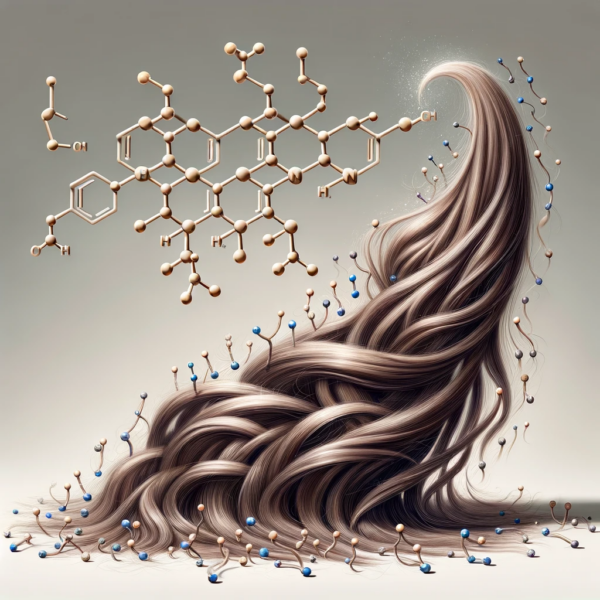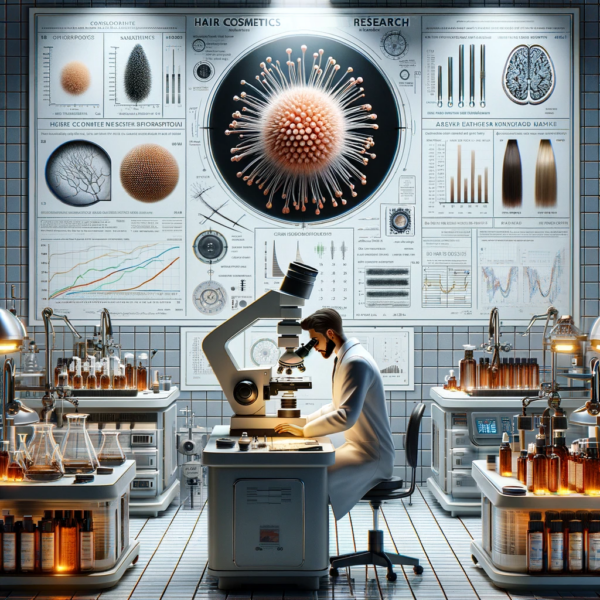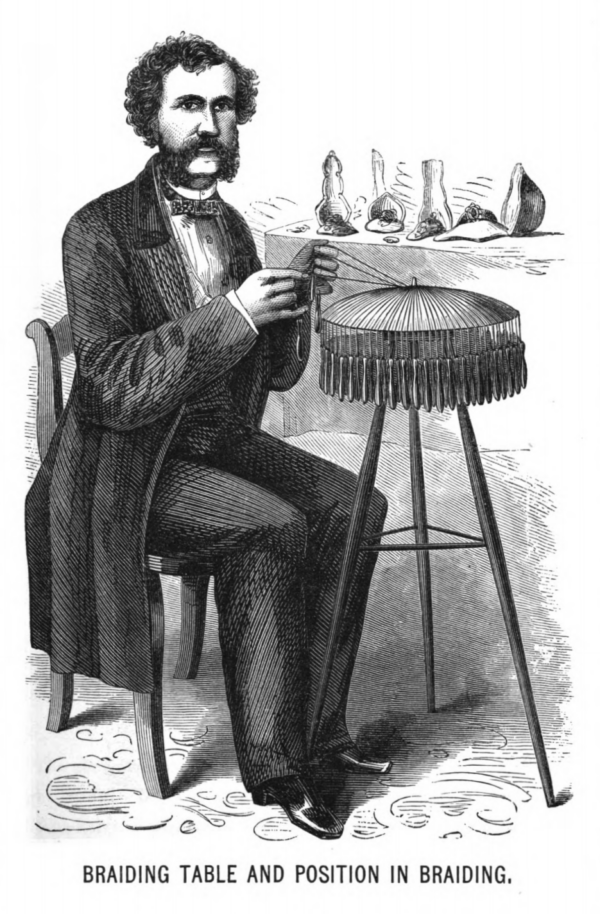Can you Eat Hair? The answer is no, but also – kind of. Some people develop an obsessive-compulsive habit of plucking and eating their hair; a condition called “trichophagia”. This is potentially a very dangerous condition because your stomach acids cannot break down the hair fiber. The hair fiber is quite irritating to the stomach and can cause ulcers. In some cases the eaten hair can collect into a hair ball and build up into a sizeable mass. This can be very dangerous, even life threatening because it irritates the stomach so much. In these cases the only treatment is an operation to remove the hair ball. As such, the answer to “can you eat hair safely” is a definite no!
However, hair fiber is made from keratin and hair keratin has high concentrations of the amino acid cysteine. Cysteine is used in the food industry, primarily as a dough conditioner. It helps to speed up the industrial processing of bread, particularly pizza dough, by reducing the time required for dough to rise. The substance is known to be effective in breaking disulfide bonds in gluten, which makes the dough easier to handle and process. Cysteine is also found in cough mixtures as acetyl-cysteine which helps to break up mucus using much the same chemical reaction. In addition, cysteine is used in many industries, it can be found in cosmetic products for example. Notably, in Japan cysteine is used in some hair perm products.
Regarding the source of cysteine, historically, one of the methods to produce this amino acid involved hydrolyzing human hair. Hair contains significant amounts of keratin, a protein rich in cysteine. This cysteine production method was particularly common in Asia, where large-scale hair collection and processing for cysteine extraction has been reported in the past. In Asian hair salons, tens of thousands of tons of hair were swept up and delivered to cysteine manufacturers every year.
Chemical hydrolysis of keratin is the traditional method of industrial production of L-cysteine. One ton of human hair yields about 100kg (about 220lbs) of pure cysteine. The world consumes over 4000 tons of cysteine every year so you can imagine the scale of the process that is involved. However, the hydrolysis method of cysteine production requires using activated charcoal and it is also consumes a large amount of hydrochloric acid. The procedure causes a very unpleasant odour as well as wastewater treatment problems, which have a significant impact on the local environment.
It’s important to note that human hair is not the only source of cysteine. Cysteine can be extracted from any keratinous biomass, such as feathers, pig bristles, wool and hooves. Interestingly, human hair was preferred as the raw material for hydrolysis processing over other animal sources as it has a richer concentration of cysteine compared to non-humnan hair and feathers. However, in recent years, there has been a concerted push to move away from human and animal derived sources of cysteine. Sourcing cysteine from human hair can be unacceptable in some religions. More generally, animal derived cysteine has become objectionable, partly due to the general perceptions of using what are essentially waste by-products of meat production, as well as an increase in veganism.
In more recent years, synthetic and microbial fermentation methods have become prevalent for the production of L-cysteine, particularly for use in food and baking. These methods are more efficient with less environmental impact compared to hydrolysis processing. Making cysteine by microbe fermentation also avoids the ethical and aesthetic concerns associated with using human or animal hair. The pharmaceutical industry also avoids using human or animal derived cysteine as they need raw materials that are guaranteed to be free from contaminants such as BSE, SARS, and avian flu. Cysteine derived from human hair is still available, but these days it is used for non-human products such as to enhance meat aroma in cat and dog food.
Therefore, while the claim that food additive cysteine is extracted from human hair has a basis in historical practices, it no longer represents the current methods of cysteine production (at least for human consumption) which are more diverse and include synthetic and fermentation processes. It’s also worth noting that the use of cysteine, regardless of its source, is regulated by food safety authorities in various countries to ensure it is safe for consumption. Indeed, its use is explicitly banned for food additives and cosmetic products in the European Union.
In conclusion, while consuming hair directly is hazardous due to its indigestibility and potential to cause severe health issues, the amino acid cysteine derived from keratin, which is abundant in hair, plays a significant role in various industries. Historically, human hair was a primary source for extracting cysteine, especially in Asia. However, contemporary practices increasingly favor synthetic and microbial fermentation methods. These modern techniques, being more efficient and environmentally friendly, also address ethical concerns related to the use of human and animal-derived materials. Consequently, while hair itself should not be consumed, its components, particularly cysteine, continue to be valuable in diverse applications from food processing to pharmaceuticals.
Bibliography
11711645 {11711645:GT2BTZN9},{11711645:MJ54HPSV},{11711645:T84JGFBW},{11711645:NBW7ZRWS},{11711645:P77W5CUN},{11711645:R33JXZDN},{11711645:RE5JNJZG},{11711645:TWDRFDAF},{11711645:3HJNS9U6},{11711645:F8W3Z2SF},{11711645:6QAWXX6Q},{11711645:N9I7NI48} vancouver 50 date asc 1094 https://www.keratin.com/wp-content/plugins/zotpress/ %7B%22status%22%3A%22success%22%2C%22updateneeded%22%3Afalse%2C%22instance%22%3A%22zotpress-41ea405dd194e25efe0a174e816d3e1d%22%2C%22meta%22%3A%7B%22request_last%22%3A0%2C%22request_next%22%3A0%2C%22used_cache%22%3Atrue%7D%2C%22data%22%3A%5B%7B%22key%22%3A%22F8W3Z2SF%22%2C%22library%22%3A%7B%22id%22%3A11711645%7D%2C%22meta%22%3A%7B%22creatorSummary%22%3A%22Yu%20et%20al.%22%2C%22parsedDate%22%3A%221993-07-01%22%2C%22numChildren%22%3A0%7D%2C%22bib%22%3A%22%3Cdiv%20class%3D%5C%22csl-bib-body%5C%22%20style%3D%5C%22line-height%3A%201.35%3B%20%5C%22%3E%5Cn%20%20%3Cdiv%20class%3D%5C%22csl-entry%5C%22%20style%3D%5C%22clear%3A%20left%3B%20%5C%22%3E%5Cn%20%20%20%20%3Cdiv%20class%3D%5C%22csl-left-margin%5C%22%20style%3D%5C%22float%3A%20left%3B%20padding-right%3A%200.5em%3B%20text-align%3A%20right%3B%20width%3A%201em%3B%5C%22%3E1.%3C%5C%2Fdiv%3E%3Cdiv%20class%3D%5C%22csl-right-inline%5C%22%20style%3D%5C%22margin%3A%200%20.4em%200%201.5em%3B%5C%22%3EYu%20J%2C%20Yu%20D%20wen%2C%20Checkla%20DM%2C%20Freedberg%20IM%2C%20Bertolino%20AP.%20Human%20hair%20keratins.%20Journal%20of%20Investigative%20Dermatology.%201993%20Jul%201%3B101%281%2C%20Supplement%29%3AS56%26%23x2013%3B9.%3C%5C%2Fdiv%3E%5Cn%20%20%20%3C%5C%2Fdiv%3E%5Cn%3C%5C%2Fdiv%3E%22%2C%22data%22%3A%7B%22itemType%22%3A%22journalArticle%22%2C%22title%22%3A%22Human%20hair%20keratins%22%2C%22creators%22%3A%5B%7B%22creatorType%22%3A%22author%22%2C%22firstName%22%3A%22Jialin%22%2C%22lastName%22%3A%22Yu%22%7D%2C%7B%22creatorType%22%3A%22author%22%2C%22firstName%22%3A%22Da-wen%22%2C%22lastName%22%3A%22Yu%22%7D%2C%7B%22creatorType%22%3A%22author%22%2C%22firstName%22%3A%22Daniel%20M.%22%2C%22lastName%22%3A%22Checkla%22%7D%2C%7B%22creatorType%22%3A%22author%22%2C%22firstName%22%3A%22Irwin%20M.%22%2C%22lastName%22%3A%22Freedberg%22%7D%2C%7B%22creatorType%22%3A%22author%22%2C%22firstName%22%3A%22Arthur%20P.%22%2C%22lastName%22%3A%22Bertolino%22%7D%5D%2C%22abstractNote%22%3A%22Human%20hair%20keratins%20were%20among%20the%20first%20to%20be%20studied%20but%20it%20is%20only%20recently%20that%20sufficient%20information%20has%20been%20obtained%20to%20gain%20a%20basic%20biologic%20perspective%20of%20these%20proteins.%20Hair%20keratins%20are%20members%20of%20the%20intermediate%20filament%20family%20of%20proteins%2C%20yet%20are%20sufficiently%20divergent%20from%20epidermal%20keratins%20to%20warrant%20separate%20classification%3A%20type%20Ia%20and%20IIa%20%28%5Cu201chard%5Cu201d%5C%2Fhair%20keratins%29%20and%20type%20Ib%20and%20IIb%20%28epidermal%20and%20other%20%5Cu201csoft%5Cu201d%20keratins%29.%20As%20with%20hair%20keratins%20from%20other%20species%2C%20the%20human%20proteins%20may%20be%20distinguished%20from%20their%20epidermal%20counterparts%20by%20a%20relatively%20higher%20cysteine%20content%2C%207.6%25%20versus%202.9%25%2C%20respectively.%20This%20feature%20reflects%20utilization%20of%20disulfide%20bonding%20in%20producing%20a%20tougher%2C%20more%20durable%20structure%20in%20the%20tissues%20in%20which%20the%20hair%20keratins%20are%20distributed.%20Although%20prominent%20in%20hair%2C%20their%20distribution%20is%20not%20strictly%20limited%20to%20this%20tissue.%20A%20number%20of%20molecular%20characteristics%20have%20been%20elucidated%20from%20human%20hair%20keratin%20gene%20studies%20including%20amino%20acid%20sequence%20data%20for%20a%20type%20Ia%20hair%20keratin.%20Studies%20of%20various%20pedigrees%20has%20revealed%20a%20fairly%20wide%20latitude%20of%20variation%20in%20human%20hair%20keratin%20expression%20that%20is%20tolerated%20without%20associated%20obvious%20hair%20phenotypic%20change.%20Thus%2C%20a%20foundation%20of%20knowledge%20regarding%20these%20proteins%20has%20emerged%20and%20continues%20to%20evolve.%22%2C%22date%22%3A%221993-07-01%22%2C%22language%22%3A%22%22%2C%22DOI%22%3A%2210.1016%5C%2F0022-202X%2893%2990501-8%22%2C%22ISSN%22%3A%220022-202X%22%2C%22url%22%3A%22%22%2C%22collections%22%3A%5B%22DFF983GW%22%5D%2C%22dateModified%22%3A%222024-01-24T20%3A48%3A20Z%22%7D%7D%2C%7B%22key%22%3A%22NBW7ZRWS%22%2C%22library%22%3A%7B%22id%22%3A11711645%7D%2C%22meta%22%3A%7B%22creatorSummary%22%3A%22Khawar%20et%20al.%22%2C%22parsedDate%22%3A%221997-02%22%2C%22numChildren%22%3A0%7D%2C%22bib%22%3A%22%3Cdiv%20class%3D%5C%22csl-bib-body%5C%22%20style%3D%5C%22line-height%3A%201.35%3B%20%5C%22%3E%5Cn%20%20%3Cdiv%20class%3D%5C%22csl-entry%5C%22%20style%3D%5C%22clear%3A%20left%3B%20%5C%22%3E%5Cn%20%20%20%20%3Cdiv%20class%3D%5C%22csl-left-margin%5C%22%20style%3D%5C%22float%3A%20left%3B%20padding-right%3A%200.5em%3B%20text-align%3A%20right%3B%20width%3A%201em%3B%5C%22%3E1.%3C%5C%2Fdiv%3E%3Cdiv%20class%3D%5C%22csl-right-inline%5C%22%20style%3D%5C%22margin%3A%200%20.4em%200%201.5em%3B%5C%22%3EKhawar%20SL%2C%20Watson%20K%2C%20Jones%20GL.%20A%20comparative%20electrophoretic%20analysis%20of%20mammalian%20hair%20and%20avian%20feather%20proteins.%20Int%20J%20Biochem%20Cell%20Biol.%201997%20Feb%3B29%282%29%3A367%26%23x2013%3B80.%3C%5C%2Fdiv%3E%5Cn%20%20%20%3C%5C%2Fdiv%3E%5Cn%3C%5C%2Fdiv%3E%22%2C%22data%22%3A%7B%22itemType%22%3A%22journalArticle%22%2C%22title%22%3A%22A%20comparative%20electrophoretic%20analysis%20of%20mammalian%20hair%20and%20avian%20feather%20proteins%22%2C%22creators%22%3A%5B%7B%22creatorType%22%3A%22author%22%2C%22firstName%22%3A%22S.%20L.%22%2C%22lastName%22%3A%22Khawar%22%7D%2C%7B%22creatorType%22%3A%22author%22%2C%22firstName%22%3A%22K.%22%2C%22lastName%22%3A%22Watson%22%7D%2C%7B%22creatorType%22%3A%22author%22%2C%22firstName%22%3A%22G.%20L.%22%2C%22lastName%22%3A%22Jones%22%7D%5D%2C%22abstractNote%22%3A%22An%20improved%20one-dimensional%20sodium%20dodecyl%20sulphate%20separation%20has%20allowed%20a%20detailed%20electrophoretic%20comparison%20of%20the%20proteins%20that%20constitute%20hairs%20and%20feathers%20isolated%20from%20various%20representative%20samples%20of%20mammalian%2C%20both%20placental%20and%20marsupial%20and%20avian%20species.%20The%20proteins%20from%20various%20species%20were%20S-carboxymethylated%20using%20labelled%20%2814C%29-iodoacetic%20acid%20and%20detected%20both%20by%20Coomassie%20stain%20and%20fluorography.%20Proteins%20from%20mammalian%20species%20were%20compared%20with%20respect%20to%20their%20molecular%20masses%20and%20relative%20cysteine%20content%20using%20laser%20densitometry%20of%20both%20Coomassie%20stained%20gels%20and%20fluorographs%20of%2014C%20labelled%20gels.%20These%20results%20may%20be%20quite%20useful%20forensically%20as%20an%20adjunct%20to%20fibre%20analysis.%22%2C%22date%22%3A%221997-02%22%2C%22language%22%3A%22eng%22%2C%22DOI%22%3A%2210.1016%5C%2Fs1357-2725%2896%2900081-7%22%2C%22ISSN%22%3A%221357-2725%22%2C%22url%22%3A%22%22%2C%22collections%22%3A%5B%22DFF983GW%22%5D%2C%22dateModified%22%3A%222024-01-24T20%3A55%3A40Z%22%7D%7D%2C%7B%22key%22%3A%226QAWXX6Q%22%2C%22library%22%3A%7B%22id%22%3A11711645%7D%2C%22meta%22%3A%7B%22parsedDate%22%3A%222009-11-30%22%2C%22numChildren%22%3A0%7D%2C%22bib%22%3A%22%3Cdiv%20class%3D%5C%22csl-bib-body%5C%22%20style%3D%5C%22line-height%3A%201.35%3B%20%5C%22%3E%5Cn%20%20%3Cdiv%20class%3D%5C%22csl-entry%5C%22%20style%3D%5C%22clear%3A%20left%3B%20%5C%22%3E%5Cn%20%20%20%20%3Cdiv%20class%3D%5C%22csl-left-margin%5C%22%20style%3D%5C%22float%3A%20left%3B%20padding-right%3A%200.5em%3B%20text-align%3A%20right%3B%20width%3A%201em%3B%5C%22%3E1.%3C%5C%2Fdiv%3E%3Cdiv%20class%3D%5C%22csl-right-inline%5C%22%20style%3D%5C%22margin%3A%200%20.4em%200%201.5em%3B%5C%22%3ERegulation%20%28EC%29%20No%201223%5C%2F2009%20of%20the%20European%20Parliament%20and%20of%20the%20Council%20of%2030%20November%202009%20on%20cosmetic%20products.%20OJ%20L%20Nov%2030%2C%202009.%3C%5C%2Fdiv%3E%5Cn%20%20%20%3C%5C%2Fdiv%3E%5Cn%3C%5C%2Fdiv%3E%22%2C%22data%22%3A%7B%22itemType%22%3A%22statute%22%2C%22nameOfAct%22%3A%22Regulation%20%28EC%29%20No%201223%5C%2F2009%20of%20the%20European%20Parliament%20and%20of%20the%20Council%20of%2030%20November%202009%20on%20cosmetic%20products%22%2C%22creators%22%3A%5B%5D%2C%22abstractNote%22%3A%22%22%2C%22code%22%3A%22OJ%20L%22%2C%22codeNumber%22%3A%22342%22%2C%22publicLawNumber%22%3A%22%22%2C%22dateEnacted%22%3A%222009-11-30%22%2C%22section%22%3A%22%22%2C%22session%22%3A%22%22%2C%22history%22%3A%22%22%2C%22language%22%3A%22en%22%2C%22url%22%3A%22%22%2C%22collections%22%3A%5B%22DFF983GW%22%5D%2C%22dateModified%22%3A%222024-01-24T20%3A24%3A56Z%22%7D%7D%2C%7B%22key%22%3A%22N9I7NI48%22%2C%22library%22%3A%7B%22id%22%3A11711645%7D%2C%22meta%22%3A%7B%22parsedDate%22%3A%222012-03-09%22%2C%22numChildren%22%3A0%7D%2C%22bib%22%3A%22%3Cdiv%20class%3D%5C%22csl-bib-body%5C%22%20style%3D%5C%22line-height%3A%201.35%3B%20%5C%22%3E%5Cn%20%20%3Cdiv%20class%3D%5C%22csl-entry%5C%22%20style%3D%5C%22clear%3A%20left%3B%20%5C%22%3E%5Cn%20%20%20%20%3Cdiv%20class%3D%5C%22csl-left-margin%5C%22%20style%3D%5C%22float%3A%20left%3B%20padding-right%3A%200.5em%3B%20text-align%3A%20right%3B%20width%3A%201em%3B%5C%22%3E1.%3C%5C%2Fdiv%3E%3Cdiv%20class%3D%5C%22csl-right-inline%5C%22%20style%3D%5C%22margin%3A%200%20.4em%200%201.5em%3B%5C%22%3ECommission%20Regulation%20%28EU%29%20No%26%23xA0%3B231%5C%2F2012%20of%209%26%23xA0%3BMarch%202012%20laying%20down%20specifications%20for%20food%20additives%20listed%20in%20Annexes%20II%20and%20III%20to%20Regulation%20%28EC%29%20No%26%23xA0%3B1333%5C%2F2008%20of%20the%20European%20Parliament%20and%20of%20the%20Council%26%23xA0%3B%20Text%20with%20EEA%20relevance.%20OJ%20L%20Mar%209%2C%202012.%3C%5C%2Fdiv%3E%5Cn%20%20%20%3C%5C%2Fdiv%3E%5Cn%3C%5C%2Fdiv%3E%22%2C%22data%22%3A%7B%22itemType%22%3A%22statute%22%2C%22nameOfAct%22%3A%22Commission%20Regulation%20%28EU%29%20No%5Cu00a0231%5C%2F2012%20of%209%5Cu00a0March%202012%20laying%20down%20specifications%20for%20food%20additives%20listed%20in%20Annexes%20II%20and%20III%20to%20Regulation%20%28EC%29%20No%5Cu00a01333%5C%2F2008%20of%20the%20European%20Parliament%20and%20of%20the%20Council%20%20Text%20with%20EEA%20relevance%22%2C%22creators%22%3A%5B%5D%2C%22abstractNote%22%3A%22%22%2C%22code%22%3A%22OJ%20L%22%2C%22codeNumber%22%3A%22083%22%2C%22publicLawNumber%22%3A%22%22%2C%22dateEnacted%22%3A%222012-03-09%22%2C%22section%22%3A%22%22%2C%22session%22%3A%22%22%2C%22history%22%3A%22%22%2C%22language%22%3A%22en%22%2C%22url%22%3A%22%22%2C%22collections%22%3A%5B%22DFF983GW%22%5D%2C%22dateModified%22%3A%222024-01-25T17%3A46%3A43Z%22%7D%7D%2C%7B%22key%22%3A%22T84JGFBW%22%2C%22library%22%3A%7B%22id%22%3A11711645%7D%2C%22meta%22%3A%7B%22creatorSummary%22%3A%22Hashim%20et%20al.%22%2C%22parsedDate%22%3A%222014-10-15%22%2C%22numChildren%22%3A0%7D%2C%22bib%22%3A%22%3Cdiv%20class%3D%5C%22csl-bib-body%5C%22%20style%3D%5C%22line-height%3A%201.35%3B%20%5C%22%3E%5Cn%20%20%3Cdiv%20class%3D%5C%22csl-entry%5C%22%20style%3D%5C%22clear%3A%20left%3B%20%5C%22%3E%5Cn%20%20%20%20%3Cdiv%20class%3D%5C%22csl-left-margin%5C%22%20style%3D%5C%22float%3A%20left%3B%20padding-right%3A%200.5em%3B%20text-align%3A%20right%3B%20width%3A%201em%3B%5C%22%3E1.%3C%5C%2Fdiv%3E%3Cdiv%20class%3D%5C%22csl-right-inline%5C%22%20style%3D%5C%22margin%3A%200%20.4em%200%201.5em%3B%5C%22%3EHashim%20Y%2C%20Ismail%20N%2C%20Jamal%20P%2C%20Othman%20R%2C%20Salleh%20H.%20Production%20of%20Cysteine%3A%20Approaches%2C%20Challenges%20and%20Potential%20Solution.%20Int%20J%20Biotech%20Well%20Indus.%202014%20Oct%2015%3B3%283%29%3A95%26%23x2013%3B101.%3C%5C%2Fdiv%3E%5Cn%20%20%20%3C%5C%2Fdiv%3E%5Cn%3C%5C%2Fdiv%3E%22%2C%22data%22%3A%7B%22itemType%22%3A%22journalArticle%22%2C%22title%22%3A%22Production%20of%20Cysteine%3A%20Approaches%2C%20Challenges%20and%20Potential%20Solution%22%2C%22creators%22%3A%5B%7B%22creatorType%22%3A%22author%22%2C%22firstName%22%3A%22Yum%22%2C%22lastName%22%3A%22Hashim%22%7D%2C%7B%22creatorType%22%3A%22author%22%2C%22firstName%22%3A%22Nur%22%2C%22lastName%22%3A%22Ismail%22%7D%2C%7B%22creatorType%22%3A%22author%22%2C%22firstName%22%3A%22Parveen%22%2C%22lastName%22%3A%22Jamal%22%7D%2C%7B%22creatorType%22%3A%22author%22%2C%22firstName%22%3A%22Rashidi%22%2C%22lastName%22%3A%22Othman%22%7D%2C%7B%22creatorType%22%3A%22author%22%2C%22firstName%22%3A%22Hamzah%22%2C%22lastName%22%3A%22Salleh%22%7D%5D%2C%22abstractNote%22%3A%22%22%2C%22date%22%3A%222014-10-15%22%2C%22language%22%3A%22%22%2C%22DOI%22%3A%2210.6000%5C%2F1927-3037.2014.03.03.3%22%2C%22ISSN%22%3A%2219273037%22%2C%22url%22%3A%22%22%2C%22collections%22%3A%5B%22DFF983GW%22%5D%2C%22dateModified%22%3A%222024-01-24T17%3A55%3A59Z%22%7D%7D%2C%7B%22key%22%3A%223HJNS9U6%22%2C%22library%22%3A%7B%22id%22%3A11711645%7D%2C%22meta%22%3A%7B%22creatorSummary%22%3A%22Takagi%20and%20Ohtsu%22%2C%22parsedDate%22%3A%222017%22%2C%22numChildren%22%3A0%7D%2C%22bib%22%3A%22%3Cdiv%20class%3D%5C%22csl-bib-body%5C%22%20style%3D%5C%22line-height%3A%201.35%3B%20%5C%22%3E%5Cn%20%20%3Cdiv%20class%3D%5C%22csl-entry%5C%22%20style%3D%5C%22clear%3A%20left%3B%20%5C%22%3E%5Cn%20%20%20%20%3Cdiv%20class%3D%5C%22csl-left-margin%5C%22%20style%3D%5C%22float%3A%20left%3B%20padding-right%3A%200.5em%3B%20text-align%3A%20right%3B%20width%3A%201em%3B%5C%22%3E1.%3C%5C%2Fdiv%3E%3Cdiv%20class%3D%5C%22csl-right-inline%5C%22%20style%3D%5C%22margin%3A%200%20.4em%200%201.5em%3B%5C%22%3ETakagi%20H%2C%20Ohtsu%20I.%20L-Cysteine%20Metabolism%20and%20Fermentation%20in%20Microorganisms.%20Adv%20Biochem%20Eng%20Biotechnol.%202017%3B159%3A129%26%23x2013%3B51.%3C%5C%2Fdiv%3E%5Cn%20%20%20%3C%5C%2Fdiv%3E%5Cn%3C%5C%2Fdiv%3E%22%2C%22data%22%3A%7B%22itemType%22%3A%22journalArticle%22%2C%22title%22%3A%22L-Cysteine%20Metabolism%20and%20Fermentation%20in%20Microorganisms%22%2C%22creators%22%3A%5B%7B%22creatorType%22%3A%22author%22%2C%22firstName%22%3A%22Hiroshi%22%2C%22lastName%22%3A%22Takagi%22%7D%2C%7B%22creatorType%22%3A%22author%22%2C%22firstName%22%3A%22Iwao%22%2C%22lastName%22%3A%22Ohtsu%22%7D%5D%2C%22abstractNote%22%3A%22L-Cysteine%20is%20an%20important%20amino%20acid%20both%20biologically%20and%20commercially.%20Although%20most%20amino%20acids%20are%20industrially%20produced%20by%20microbial%20fermentation%2C%20L-cysteine%20has%20been%20mainly%20produced%20by%20protein%20hydrolysis.%20Due%20to%20environmental%20and%20safety%20problems%2C%20synthetic%20or%20biotechnological%20products%20have%20been%20preferred%20in%20the%20market.%20Here%2C%20we%20reviewed%20L-cysteine%20metabolism%2C%20including%20biosynthesis%2C%20degradation%2C%20and%20transport%2C%20and%20biotechnological%20production%20%28including%20both%20enzymatic%20and%20fermentation%20processes%29%20of%20L-cysteine.%20The%20metabolic%20regulation%20of%20L-cysteine%20including%20novel%20sulfur%20metabolic%20pathways%20found%20in%20microorganisms%20is%20also%20discussed.%20Recent%20advancement%20in%20biochemical%20studies%2C%20genome%20sequencing%2C%20structural%20biology%2C%20and%20metabolome%20analysis%20has%20enabled%20us%20to%20use%20various%20approaches%20to%20achieve%20direct%20fermentation%20of%20L-cysteine%20from%20glucose.%20For%20example%2C%20worldwide%20companies%20began%20to%20supply%20L-cysteine%20and%20its%20derivatives%20produced%20by%20bacterial%20fermentation.%20These%20companies%20successfully%20optimized%20the%20original%20metabolism%20of%20their%20private%20strains.%20Basically%2C%20a%20combination%20of%20three%20factors%20should%20be%20required%20for%20improving%20L-cysteine%20fermentation%3A%20that%20is%2C%20%281%29%20enhancing%20biosynthesis%3A%20overexpression%20of%20the%20altered%20cysE%20gene%20encoding%20feedback%20inhibition-insensitive%20L-serine%20O-acetyltransferase%20%28SAT%29%2C%20%282%29%20weakening%20degradation%3A%20knockout%20of%20the%20genes%20encoding%20L-cysteine%20desulfhydrases%2C%20and%20%283%29%20exploiting%20export%20system%3A%20overexpression%20of%20the%20gene%20involved%20in%20L-cysteine%20transport.%20Moreover%2C%20we%20found%20that%20%5C%22thiosulfate%5C%22%20is%20much%20more%20effective%20sulfur%20source%20than%20commonly%20used%20%5C%22sulfate%5C%22%20for%20L-cysteine%20production%20in%20Escherichia%20coli%2C%20because%20thiosulfate%20is%20advantageous%20for%20saving%20consumption%20of%20NADPH%20and%20relating%20energy%20molecules.%22%2C%22date%22%3A%222017%22%2C%22language%22%3A%22eng%22%2C%22DOI%22%3A%2210.1007%5C%2F10_2016_29%22%2C%22ISSN%22%3A%220724-6145%22%2C%22url%22%3A%22%22%2C%22collections%22%3A%5B%22DFF983GW%22%5D%2C%22dateModified%22%3A%222024-01-24T20%3A59%3A19Z%22%7D%7D%2C%7B%22key%22%3A%22TWDRFDAF%22%2C%22library%22%3A%7B%22id%22%3A11711645%7D%2C%22meta%22%3A%7B%22creatorSummary%22%3A%22Sameem%20et%20al.%22%2C%22parsedDate%22%3A%222019-01-01%22%2C%22numChildren%22%3A0%7D%2C%22bib%22%3A%22%3Cdiv%20class%3D%5C%22csl-bib-body%5C%22%20style%3D%5C%22line-height%3A%201.35%3B%20%5C%22%3E%5Cn%20%20%3Cdiv%20class%3D%5C%22csl-entry%5C%22%20style%3D%5C%22clear%3A%20left%3B%20%5C%22%3E%5Cn%20%20%20%20%3Cdiv%20class%3D%5C%22csl-left-margin%5C%22%20style%3D%5C%22float%3A%20left%3B%20padding-right%3A%200.5em%3B%20text-align%3A%20right%3B%20width%3A%201em%3B%5C%22%3E1.%3C%5C%2Fdiv%3E%3Cdiv%20class%3D%5C%22csl-right-inline%5C%22%20style%3D%5C%22margin%3A%200%20.4em%200%201.5em%3B%5C%22%3ESameem%20B%2C%20Khan%20F%2C%20Niaz%20K.%20Chapter%202.6%20-%20l-Cysteine.%20In%3A%20Nabavi%20SM%2C%20Silva%20AS%2C%20editors.%20Nonvitamin%20and%20Nonmineral%20Nutritional%20Supplements.%20Academic%20Press%3B%202019.%20p.%2053%26%23x2013%3B8.%3C%5C%2Fdiv%3E%5Cn%20%20%20%3C%5C%2Fdiv%3E%5Cn%3C%5C%2Fdiv%3E%22%2C%22data%22%3A%7B%22itemType%22%3A%22bookSection%22%2C%22title%22%3A%22Chapter%202.6%20-%20l-Cysteine%22%2C%22creators%22%3A%5B%7B%22creatorType%22%3A%22author%22%2C%22firstName%22%3A%22Bilqees%22%2C%22lastName%22%3A%22Sameem%22%7D%2C%7B%22creatorType%22%3A%22author%22%2C%22firstName%22%3A%22Fazlullah%22%2C%22lastName%22%3A%22Khan%22%7D%2C%7B%22creatorType%22%3A%22author%22%2C%22firstName%22%3A%22Kamal%22%2C%22lastName%22%3A%22Niaz%22%7D%2C%7B%22creatorType%22%3A%22editor%22%2C%22firstName%22%3A%22Seyed%20Mohammad%22%2C%22lastName%22%3A%22Nabavi%22%7D%2C%7B%22creatorType%22%3A%22editor%22%2C%22firstName%22%3A%22Ana%20Sanches%22%2C%22lastName%22%3A%22Silva%22%7D%5D%2C%22abstractNote%22%3A%22l-cysteine%20is%20a%20proteingenic%20amino%20acid%2C%20which%20contributes%20toward%20a%20multitude%20of%20functions%20in%20biological%20systems.%20Cysteine%20is%20classified%20as%20a%20semiessential%20amino%20acid%20and%20can%20be%20synthesized%20in%20the%20liver%20from%20methionine%2C%20which%20is%20a%20sulfur-containing%20amino%20acid.%20This%20makes%20the%20abundance%20of%20methionine%20a%20critical%20factor%20to%20human%20health.%20As%20a%20building%20block%2C%20l-cysteine%20contributes%202%25%20of%20the%20total%20structural%20proteins%20in%20the%20body%20in%20the%20form%20of%20connective%20tissue%2C%20cell%20membranes%2C%20and%20the%20myelin%20sheaths%20around%20neurons%2C%20structures%2C%20which%20protect%20neurons%20from%20oxidative%20stress%20and%20harsh%20environmental%20conditions.%20The%20stiffness%20of%20the%20connective%20tissue%20neutralizes%20heavy%20metals%20in%20the%20body.%20l-cysteine%20is%20a%20hydrophilic%20amino%20acid%2C%20possesses%20a%20thiol%20moiety%20which%20contributes%20toward%20its%20antioxidative%20properties%2C%20and%20has%20a%20high%20reactivity%20and%20affinity%20for%20heavy%20metals%20like%20mercury%20%28Hg%29%2C%20leading%20to%20their%20excretion%5C%2Fdetoxification%20from%20the%20body%20%28Jan%20et%20al.%2C%202015%29.%20It%20is%20given%20as%20a%20supplement%20in%20the%20form%20of%20precursor%20called%20N-acetyl-l-cysteine%20%28NAC%29.%20The%20body%20synthesizes%20glutathione%20%28GSH%29%20from%20cysteine%3B%20the%20former%20is%20a%20powerful%20antioxidant%2C%20toxin%5C%2Fradical%20scavenger.%20Glutathione%20%28GHS%29%20stimulates%20the%20production%20of%20leukotriene%20which%20is%20a%20key%20element%20in%20the%20body%27s%20defense%20system%2C%20inhibits%20inflammatory%20processes%2C%20and%20boosts%20the%20immune%20system.%20Studies%20have%20revealed%20that%20NAC%20can%20be%20helpful%20in%20treating%20many%20health%20problems%20like%20osteoporosis%2C%20acute%20respiratory%20diseases%2C%20and%20acetaminophen%20poisoning.%20In%20this%20chapter%2C%20we%20highlighted%20the%20structure%2C%20biochemistry%2C%20bioavailability%2C%20sources%2C%20possible%20interactions%20with%20drugs%2C%20foods%2C%20and%20other%20supplements%2C%20and%20health%20effects%20of%20l-cysteine.%22%2C%22bookTitle%22%3A%22Nonvitamin%20and%20Nonmineral%20Nutritional%20Supplements%22%2C%22date%22%3A%222019-01-01%22%2C%22language%22%3A%22%22%2C%22ISBN%22%3A%229780128124918%22%2C%22url%22%3A%22%22%2C%22collections%22%3A%5B%22DFF983GW%22%5D%2C%22dateModified%22%3A%222024-01-24T20%3A50%3A33Z%22%7D%7D%2C%7B%22key%22%3A%22GT2BTZN9%22%2C%22library%22%3A%7B%22id%22%3A11711645%7D%2C%22meta%22%3A%7B%22creatorSummary%22%3A%22Anastassakis%22%2C%22parsedDate%22%3A%222022%22%2C%22numChildren%22%3A0%7D%2C%22bib%22%3A%22%3Cdiv%20class%3D%5C%22csl-bib-body%5C%22%20style%3D%5C%22line-height%3A%201.35%3B%20%5C%22%3E%5Cn%20%20%3Cdiv%20class%3D%5C%22csl-entry%5C%22%20style%3D%5C%22clear%3A%20left%3B%20%5C%22%3E%5Cn%20%20%20%20%3Cdiv%20class%3D%5C%22csl-left-margin%5C%22%20style%3D%5C%22float%3A%20left%3B%20padding-right%3A%200.5em%3B%20text-align%3A%20right%3B%20width%3A%201em%3B%5C%22%3E1.%3C%5C%2Fdiv%3E%3Cdiv%20class%3D%5C%22csl-right-inline%5C%22%20style%3D%5C%22margin%3A%200%20.4em%200%201.5em%3B%5C%22%3EAnastassakis%20K.%20Cysteine%20and%20Cystine.%20In%3A%20Anastassakis%20K%2C%20editor.%20Androgenetic%20Alopecia%20From%20A%20to%20Z%26%23xA0%3B%20%3A%20Vol%202%20Drugs%2C%20Herbs%2C%20Nutrition%20and%20Supplements.%20Cham%3A%20Springer%20International%20Publishing%3B%202022.%20p.%20211%26%23x2013%3B8.%3C%5C%2Fdiv%3E%5Cn%20%20%20%3C%5C%2Fdiv%3E%5Cn%3C%5C%2Fdiv%3E%22%2C%22data%22%3A%7B%22itemType%22%3A%22bookSection%22%2C%22title%22%3A%22Cysteine%20and%20Cystine%22%2C%22creators%22%3A%5B%7B%22creatorType%22%3A%22author%22%2C%22firstName%22%3A%22Konstantinos%22%2C%22lastName%22%3A%22Anastassakis%22%7D%2C%7B%22creatorType%22%3A%22editor%22%2C%22firstName%22%3A%22Konstantinos%22%2C%22lastName%22%3A%22Anastassakis%22%7D%5D%2C%22abstractNote%22%3A%22Cysteine%20is%20a%20sulfur-containing%2C%20%5Cu03b1-amino%20acid%20with%20the%20chemical%20formula%20O2CCH%28NH2%29CH2SH.%20Cysteine%20is%20unique%20amongst%20the%2020%20natural%20amino%20acids%20as%20it%20contains%20a%20thiol%20group.%20It%20is%20classified%20as%20a%20conditionally%20non-essential%20amino%20acid%20since%20the%20human%20body%20can%20naturally%20synthesize%20it%20%5B1%2C%202%5D.%20Like%20other%20amino%20acids%2C%20cysteine%20has%20an%20amphoteric%20character%20and%20is%20extensively%20used%20as%20an%20additive%20in%20the%20food%20industry%2C%20mainly%20in%20bakery%2C%20in%20the%20production%20of%20flavors%2C%20and%20as%20a%20processing%20aid%20%5B3%5D.%20When%20used%20as%20a%20food%20additive%2C%20it%20is%20labeled%20as%20E920%20%5B4%5D.%22%2C%22bookTitle%22%3A%22Androgenetic%20Alopecia%20From%20A%20to%20Z%20%20%3A%20Vol.%202%20Drugs%2C%20Herbs%2C%20Nutrition%20and%20Supplements%22%2C%22date%22%3A%222022%22%2C%22language%22%3A%22en%22%2C%22ISBN%22%3A%229783031080579%22%2C%22url%22%3A%22%22%2C%22collections%22%3A%5B%22DFF983GW%22%5D%2C%22dateModified%22%3A%222024-01-24T20%3A55%3A03Z%22%7D%7D%2C%7B%22key%22%3A%22MJ54HPSV%22%2C%22library%22%3A%7B%22id%22%3A11711645%7D%2C%22meta%22%3A%7B%22creatorSummary%22%3A%22Giteru%20et%20al.%22%2C%22parsedDate%22%3A%222023%22%2C%22numChildren%22%3A0%7D%2C%22bib%22%3A%22%3Cdiv%20class%3D%5C%22csl-bib-body%5C%22%20style%3D%5C%22line-height%3A%201.35%3B%20%5C%22%3E%5Cn%20%20%3Cdiv%20class%3D%5C%22csl-entry%5C%22%20style%3D%5C%22clear%3A%20left%3B%20%5C%22%3E%5Cn%20%20%20%20%3Cdiv%20class%3D%5C%22csl-left-margin%5C%22%20style%3D%5C%22float%3A%20left%3B%20padding-right%3A%200.5em%3B%20text-align%3A%20right%3B%20width%3A%201em%3B%5C%22%3E1.%3C%5C%2Fdiv%3E%3Cdiv%20class%3D%5C%22csl-right-inline%5C%22%20style%3D%5C%22margin%3A%200%20.4em%200%201.5em%3B%5C%22%3EGiteru%20SG%2C%20Ramsey%20DH%2C%20Hou%20Y%2C%20Cong%20L%2C%20Mohan%20A%2C%20Bekhit%20AEA.%20Wool%20keratin%20as%20a%20novel%20alternative%20protein%3A%20A%20comprehensive%20review%20of%20extraction%2C%20purification%2C%20nutrition%2C%20safety%2C%20and%20food%20applications.%20Comp%20Rev%20Food%20Sci%20Food%20Safe.%202023%3B22%281%29%3A643%26%23x2013%3B87.%3C%5C%2Fdiv%3E%5Cn%20%20%20%3C%5C%2Fdiv%3E%5Cn%3C%5C%2Fdiv%3E%22%2C%22data%22%3A%7B%22itemType%22%3A%22journalArticle%22%2C%22title%22%3A%22Wool%20keratin%20as%20a%20novel%20alternative%20protein%3A%20A%20comprehensive%20review%20of%20extraction%2C%20purification%2C%20nutrition%2C%20safety%2C%20and%20food%20applications%22%2C%22creators%22%3A%5B%7B%22creatorType%22%3A%22author%22%2C%22firstName%22%3A%22Stephen%20G.%22%2C%22lastName%22%3A%22Giteru%22%7D%2C%7B%22creatorType%22%3A%22author%22%2C%22firstName%22%3A%22Derek%20H.%22%2C%22lastName%22%3A%22Ramsey%22%7D%2C%7B%22creatorType%22%3A%22author%22%2C%22firstName%22%3A%22Yakun%22%2C%22lastName%22%3A%22Hou%22%7D%2C%7B%22creatorType%22%3A%22author%22%2C%22firstName%22%3A%22Lei%22%2C%22lastName%22%3A%22Cong%22%7D%2C%7B%22creatorType%22%3A%22author%22%2C%22firstName%22%3A%22Anand%22%2C%22lastName%22%3A%22Mohan%22%7D%2C%7B%22creatorType%22%3A%22author%22%2C%22firstName%22%3A%22Alaa%20El%5Cu2010Din%20Ahmed%22%2C%22lastName%22%3A%22Bekhit%22%7D%5D%2C%22abstractNote%22%3A%22Abstract%20%5Cn%20%20%20%20%20%20%20%20%20%20%20%20The%20growing%20global%20population%20and%20lifestyle%20changes%20have%20increased%20the%20demand%20for%20specialized%20diets%20that%20require%20protein%20and%20other%20essential%20nutrients%20for%20humans.%20Recent%20technological%20advances%20have%20enabled%20the%20use%20of%20food%20bioresources%20treated%20as%20waste%20as%20additional%20sources%20of%20alternative%20proteins.%20Sheep%20wool%20is%20an%20inexpensive%20and%20readily%20available%20bioresource%20containing%2095%25%5Cu201398%25%20protein%2C%20making%20it%20an%20outstanding%20potential%20source%20of%20protein%20for%20food%20and%20biotechnological%20applications.%20The%20strong%20structure%20of%20wool%20and%20its%20indigestibility%20are%20the%20main%20hurdles%20to%20achieving%20its%20potential%20as%20an%20edible%20protein.%20Although%20various%20methods%20have%20been%20investigated%20for%20the%20hydrolysis%20of%20wool%20into%20keratin%2C%20only%20a%20few%20of%20these%2C%20such%20as%20sulfitolysis%2C%20oxidation%2C%20and%20enzymatic%20processes%2C%20have%20the%20potential%20to%20generate%20edible%20keratin.%20In%20vitro%20and%20in%20vivo%20cytotoxicity%20studies%20reported%20no%20cytotoxicity%20effects%20of%20extracted%20keratin%2C%20suggesting%20its%20potential%20for%20use%20as%20a%20high%5Cu2010value%20protein%20ingredient%20that%20supports%20normal%20body%20functions.%20Keratin%20has%20a%20high%20cysteine%20content%20that%20can%20support%20healthy%20epithelia%2C%20glutathione%20synthesis%2C%20antioxidant%20functions%2C%20and%20skeletal%20muscle%20functions.%20With%20the%20recent%20spike%20in%20new%20keratin%20extraction%20methods%2C%20extensive%20long%5Cu2010term%20investigations%20that%20examine%20prolonged%20exposure%20of%20keratin%20generated%20from%20these%20techniques%20in%20animal%20and%20human%20subjects%20are%20required%20to%20ascertain%20its%20safety.%20Food%20applications%20of%20wool%20could%20improve%20the%20ecological%20footprint%20of%20sheep%20farming%20and%20unlock%20the%20potential%20of%20a%20sustainable%20protein%20source%20that%20meets%20demands%20for%20ethical%20production%20of%20animal%20protein.%22%2C%22date%22%3A%2201%5C%2F2023%22%2C%22language%22%3A%22en%22%2C%22DOI%22%3A%2210.1111%5C%2F1541-4337.13087%22%2C%22ISSN%22%3A%221541-4337%2C%201541-4337%22%2C%22url%22%3A%22%22%2C%22collections%22%3A%5B%22DFF983GW%22%5D%2C%22dateModified%22%3A%222024-01-24T20%3A16%3A06Z%22%7D%7D%2C%7B%22key%22%3A%22RE5JNJZG%22%2C%22library%22%3A%7B%22id%22%3A11711645%7D%2C%22meta%22%3A%7B%22creatorSummary%22%3A%22Renneberg%20et%20al.%22%2C%22parsedDate%22%3A%222023-01-16%22%2C%22numChildren%22%3A0%7D%2C%22bib%22%3A%22%3Cdiv%20class%3D%5C%22csl-bib-body%5C%22%20style%3D%5C%22line-height%3A%201.35%3B%20%5C%22%3E%5Cn%20%20%3Cdiv%20class%3D%5C%22csl-entry%5C%22%20style%3D%5C%22clear%3A%20left%3B%20%5C%22%3E%5Cn%20%20%20%20%3Cdiv%20class%3D%5C%22csl-left-margin%5C%22%20style%3D%5C%22float%3A%20left%3B%20padding-right%3A%200.5em%3B%20text-align%3A%20right%3B%20width%3A%201em%3B%5C%22%3E1.%3C%5C%2Fdiv%3E%3Cdiv%20class%3D%5C%22csl-right-inline%5C%22%20style%3D%5C%22margin%3A%200%20.4em%200%201.5em%3B%5C%22%3ERenneberg%20R%2C%20S%26%23xFC%3B%26%23xDF%3Bbier%20D%2C%20Berkling%20V%2C%20Loroch%20V%2C%20editors.%20High%20grade%20cysteine%20no%20longer%20has%20to%20be%20extracted%20from%20hair.%20In%3A%20Biotechnology%20for%20Beginners.%203rd%20ed.%20Academic%20Press%3B%202023.%20p.%20138.%3C%5C%2Fdiv%3E%5Cn%20%20%20%3C%5C%2Fdiv%3E%5Cn%3C%5C%2Fdiv%3E%22%2C%22data%22%3A%7B%22itemType%22%3A%22bookSection%22%2C%22title%22%3A%22High%20grade%20cysteine%20no%20longer%20has%20to%20be%20extracted%20from%20hair%22%2C%22creators%22%3A%5B%7B%22creatorType%22%3A%22contributor%22%2C%22firstName%22%3A%22Christoph%22%2C%22lastName%22%3A%22Winterhalter%22%7D%2C%7B%22creatorType%22%3A%22editor%22%2C%22firstName%22%3A%22Reinhard%22%2C%22lastName%22%3A%22Renneberg%22%7D%2C%7B%22creatorType%22%3A%22editor%22%2C%22firstName%22%3A%22Darja%22%2C%22lastName%22%3A%22S%5Cu00fc%5Cu00dfbier%22%7D%2C%7B%22creatorType%22%3A%22editor%22%2C%22firstName%22%3A%22Viola%22%2C%22lastName%22%3A%22Berkling%22%7D%2C%7B%22creatorType%22%3A%22editor%22%2C%22firstName%22%3A%22Vanya%22%2C%22lastName%22%3A%22Loroch%22%7D%5D%2C%22abstractNote%22%3A%22Biotechnology%20for%20Beginners%2C%20Third%20Edition%20presents%20the%20latest%20developments%20in%20the%20evolving%20field%20of%20biotechnology%20which%20has%20grown%20to%20such%20an%20extent%20over%20the%20past%20few%20years%20that%20increasing%20numbers%20of%20professional%5Cu2019s%20work%20in%20areas%20that%20are%20directly%20impacted%20by%20the%20science.%20This%20book%20offers%20an%20exciting%20and%20colorful%20overview%20of%20biotechnology%20for%20professionals%20and%20students%20in%20a%20wide%20array%20of%20the%20life%20sciences%2C%20including%20genetics%2C%20immunology%2C%20biochemistry%2C%20agronomy%20and%20animal%20science.%20This%20book%20will%20also%20appeals%20to%20lay%20readers%20who%20do%20not%20have%20a%20scientific%20background%20but%20are%20interested%20in%20an%20entertaining%20and%20informative%20introduction%20to%20the%20key%20aspects%20of%20biotechnology.%20Authors%20Renneberg%20and%20Loroch%20discuss%20the%20opportunities%20and%20risks%20of%20individual%20technologies%20and%20provide%20historical%20data%20in%20easy-to-reference%20boxes%2C%20highlighting%20key%20topics.%20The%20book%20covers%20all%20major%20aspects%20of%20the%20field%2C%20from%20food%20biotechnology%20to%20enzymes%2C%20genetic%20engineering%2C%20viruses%2C%20antibodies%2C%20and%20vaccines%2C%20to%20environmental%20biotechnology%2C%20transgenic%20animals%2C%20analytical%20biotechnology%2C%20and%20the%20human%20genome.%20Covers%20the%20whole%20of%20biotechnology%20Presents%20an%20extremely%20accessible%20style%2C%20including%20lavish%20and%20humorous%20illustrations%20throughout%20Includes%20new%20chapters%20on%20CRISPR%20cas-9%2C%20COVID-19%2C%20the%20biotechnology%20of%20cancer%2C%20and%20more%22%2C%22bookTitle%22%3A%22Biotechnology%20for%20Beginners%22%2C%22date%22%3A%222023-01-16%22%2C%22language%22%3A%22en%22%2C%22ISBN%22%3A%229780323855709%22%2C%22url%22%3A%22%22%2C%22collections%22%3A%5B%22DFF983GW%22%5D%2C%22dateModified%22%3A%222024-05-06T14%3A17%3A24Z%22%7D%7D%2C%7B%22key%22%3A%22P77W5CUN%22%2C%22library%22%3A%7B%22id%22%3A11711645%7D%2C%22meta%22%3A%7B%22creatorSummary%22%3A%22Kwon%20and%20Park%22%2C%22parsedDate%22%3A%222023-04-21%22%2C%22numChildren%22%3A0%7D%2C%22bib%22%3A%22%3Cdiv%20class%3D%5C%22csl-bib-body%5C%22%20style%3D%5C%22line-height%3A%201.35%3B%20%5C%22%3E%5Cn%20%20%3Cdiv%20class%3D%5C%22csl-entry%5C%22%20style%3D%5C%22clear%3A%20left%3B%20%5C%22%3E%5Cn%20%20%20%20%3Cdiv%20class%3D%5C%22csl-left-margin%5C%22%20style%3D%5C%22float%3A%20left%3B%20padding-right%3A%200.5em%3B%20text-align%3A%20right%3B%20width%3A%201em%3B%5C%22%3E1.%3C%5C%2Fdiv%3E%3Cdiv%20class%3D%5C%22csl-right-inline%5C%22%20style%3D%5C%22margin%3A%200%20.4em%200%201.5em%3B%5C%22%3EKwon%20HJ%2C%20Park%20J.%20Treatment%20of%20large%20gastric%20trichobezoar%20in%20children%3A%20Two%20case%20reports%20and%20literature%20review.%20Medicine%20%28Baltimore%29.%202023%20Apr%2021%3B102%2816%29%3Ae33589.%3C%5C%2Fdiv%3E%5Cn%20%20%20%3C%5C%2Fdiv%3E%5Cn%3C%5C%2Fdiv%3E%22%2C%22data%22%3A%7B%22itemType%22%3A%22journalArticle%22%2C%22title%22%3A%22Treatment%20of%20large%20gastric%20trichobezoar%20in%20children%3A%20Two%20case%20reports%20and%20literature%20review%22%2C%22creators%22%3A%5B%7B%22creatorType%22%3A%22author%22%2C%22firstName%22%3A%22Hyung%20Jun%22%2C%22lastName%22%3A%22Kwon%22%7D%2C%7B%22creatorType%22%3A%22author%22%2C%22firstName%22%3A%22Jinyoung%22%2C%22lastName%22%3A%22Park%22%7D%5D%2C%22abstractNote%22%3A%22RATIONALE%3A%20Gastric%20trichobezoars%20are%20a%20rare%20form%20of%20bezoar%20formed%20from%20swallowed%20human%20hair%20as%20well%20as%20hair%20from%20dolls%20or%20animals%2C%20blankets%2C%20and%20carpets.%20They%20usually%20develop%20in%20young%20women%20who%20are%20emotionally%20disturbed%2C%20depressed%2C%20or%20mentally%20retarded%2C%20with%20trichotillomania%20and%20trichophagia.%20They%20can%20lead%20to%20abdominal%20pain%2C%20gastric%20ulceration%2C%20bleeding%2C%20obstruction%2C%20and%20perforation.%5CnPATIENT%20CONCERNS%3A%20A%2013-year-old%20girl%20was%20admitted%20to%20our%20institution%20with%20complaints%20of%20nausea%2C%20vomiting%2C%20and%20epigastric%20pain%20for%202%20days.%20She%20underwent%20laparoscopic%20removal%20of%20a%20large%20gastric%20trichobezoar%20at%20our%20institution%205%20years%20ago.%20A%2012-year-old%20girl%20presented%20at%20our%20institution%20due%20to%20epigastric%20pain%2C%20dizziness%2C%20and%20melena%20for%202%20days.%5CnDIAGNOSIS%3A%20They%20were%20diagnosed%20with%20gastric%20trichobezoar%20by%20abdominal%20computed%20tomography%20scan%20and%20upper%20gastrointestinal%20endoscopy.%5CnINTERVENTIONS%3A%20Large%20gastric%20trichobezoars%20were%20removed%20via%20a%20mini-laparotomy.%5CnOUTCOMES%3A%20They%20recovered%20well%20postoperatively%20without%20complication.%5CnLESSONS%3A%20Although%20the%20recurrence%20of%20gastric%20trichobezoar%20after%20surgery%20is%20rare%2C%20few%20recurrent%20cases%20were%20reported%20in%20the%20literature.%20Therefore%2C%20psychiatric%20consultation%20and%20regular%20follow-up%20after%20treatment%20should%20be%20considered%20in%20the%20children%20and%20their%20parents%20to%20prevent%20the%20recurrence%20of%20gastric%20trichobezoar.%22%2C%22date%22%3A%222023-04-21%22%2C%22language%22%3A%22eng%22%2C%22DOI%22%3A%2210.1097%5C%2FMD.0000000000033589%22%2C%22ISSN%22%3A%221536-5964%22%2C%22url%22%3A%22%22%2C%22collections%22%3A%5B%22DFF983GW%22%5D%2C%22dateModified%22%3A%222024-01-24T21%3A03%3A03Z%22%7D%7D%2C%7B%22key%22%3A%22R33JXZDN%22%2C%22library%22%3A%7B%22id%22%3A11711645%7D%2C%22meta%22%3A%7B%22creatorSummary%22%3A%22Li%20et%20al.%22%2C%22parsedDate%22%3A%222023-09%22%2C%22numChildren%22%3A0%7D%2C%22bib%22%3A%22%3Cdiv%20class%3D%5C%22csl-bib-body%5C%22%20style%3D%5C%22line-height%3A%201.35%3B%20%5C%22%3E%5Cn%20%20%3Cdiv%20class%3D%5C%22csl-entry%5C%22%20style%3D%5C%22clear%3A%20left%3B%20%5C%22%3E%5Cn%20%20%20%20%3Cdiv%20class%3D%5C%22csl-left-margin%5C%22%20style%3D%5C%22float%3A%20left%3B%20padding-right%3A%200.5em%3B%20text-align%3A%20right%3B%20width%3A%201em%3B%5C%22%3E1.%3C%5C%2Fdiv%3E%3Cdiv%20class%3D%5C%22csl-right-inline%5C%22%20style%3D%5C%22margin%3A%200%20.4em%200%201.5em%3B%5C%22%3ELi%20W%2C%20Zhou%20Z%2C%20Wang%20D.%20Recent%20Advances%2C%20Challenges%2C%20and%20Metabolic%20Engineering%20Strategies%20in%20L-Cysteine%20Biosynthesis.%20Fermentation.%202023%20Sep%3B9%289%29%3A802.%3C%5C%2Fdiv%3E%5Cn%20%20%20%3C%5C%2Fdiv%3E%5Cn%3C%5C%2Fdiv%3E%22%2C%22data%22%3A%7B%22itemType%22%3A%22journalArticle%22%2C%22title%22%3A%22Recent%20Advances%2C%20Challenges%2C%20and%20Metabolic%20Engineering%20Strategies%20in%20L-Cysteine%20Biosynthesis%22%2C%22creators%22%3A%5B%7B%22creatorType%22%3A%22author%22%2C%22firstName%22%3A%22Wenwei%22%2C%22lastName%22%3A%22Li%22%7D%2C%7B%22creatorType%22%3A%22author%22%2C%22firstName%22%3A%22Zhen%22%2C%22lastName%22%3A%22Zhou%22%7D%2C%7B%22creatorType%22%3A%22author%22%2C%22firstName%22%3A%22Dan%22%2C%22lastName%22%3A%22Wang%22%7D%5D%2C%22abstractNote%22%3A%22L-Cysteine%20is%20a%20widely%20used%20unique%20sulfur-containing%20amino%20acid%20with%20wide%20application%20in%20the%20food%2C%20pharmaceutical%2C%20and%20agricultural%20industries.%20This%20paper%20concludes%20the%20advantages%20and%20disadvantages%20of%20chemical%20hydrolysis%2C%20enzymatic%20biotransformation%2C%20and%20fermentation%20for%20the%20synthesis%20of%20L-cysteine.%20Meanwhile%2C%20a%20detailed%20introduction%20is%20given%20to%20the%20biosynthesis%20of%20L-cysteine%2C%20metabolic%20engineering%20strategies%2C%20and%20the%20latest%20progress%20in%20reported%20L-cysteine%20fermentation%20bacteria.%20Finally%2C%20insights%20are%20provided%20on%20the%20development%20direction%20of%20increasing%20the%20production%20of%20biosynthetic%20L-cysteine%20in%20the%20future.%20This%20review%20provides%20ideas%20for%20the%20future%20development%20of%20more%20efficient%20L-cysteine%20biosynthetic%20pathways.%22%2C%22date%22%3A%222023%5C%2F9%22%2C%22language%22%3A%22en%22%2C%22DOI%22%3A%2210.3390%5C%2Ffermentation9090802%22%2C%22ISSN%22%3A%222311-5637%22%2C%22url%22%3A%22%22%2C%22collections%22%3A%5B%22DFF983GW%22%5D%2C%22dateModified%22%3A%222024-01-24T17%3A49%3A44Z%22%7D%7D%5D%7D 1.
Yu J, Yu D wen, Checkla DM, Freedberg IM, Bertolino AP. Human hair keratins. Journal of Investigative Dermatology. 1993 Jul 1;101(1, Supplement):S56–9.
1.
Khawar SL, Watson K, Jones GL. A comparative electrophoretic analysis of mammalian hair and avian feather proteins. Int J Biochem Cell Biol. 1997 Feb;29(2):367–80.
1.
Regulation (EC) No 1223/2009 of the European Parliament and of the Council of 30 November 2009 on cosmetic products. OJ L Nov 30, 2009.
1.
Commission Regulation (EU) No 231/2012 of 9 March 2012 laying down specifications for food additives listed in Annexes II and III to Regulation (EC) No 1333/2008 of the European Parliament and of the Council Text with EEA relevance. OJ L Mar 9, 2012.
1.
Hashim Y, Ismail N, Jamal P, Othman R, Salleh H. Production of Cysteine: Approaches, Challenges and Potential Solution. Int J Biotech Well Indus. 2014 Oct 15;3(3):95–101.
1.
Takagi H, Ohtsu I. L-Cysteine Metabolism and Fermentation in Microorganisms. Adv Biochem Eng Biotechnol. 2017;159:129–51.
1.
Sameem B, Khan F, Niaz K. Chapter 2.6 - l-Cysteine. In: Nabavi SM, Silva AS, editors. Nonvitamin and Nonmineral Nutritional Supplements. Academic Press; 2019. p. 53–8.
1.
Anastassakis K. Cysteine and Cystine. In: Anastassakis K, editor. Androgenetic Alopecia From A to Z : Vol 2 Drugs, Herbs, Nutrition and Supplements. Cham: Springer International Publishing; 2022. p. 211–8.
1.
Giteru SG, Ramsey DH, Hou Y, Cong L, Mohan A, Bekhit AEA. Wool keratin as a novel alternative protein: A comprehensive review of extraction, purification, nutrition, safety, and food applications. Comp Rev Food Sci Food Safe. 2023;22(1):643–87.
1.
Renneberg R, Süßbier D, Berkling V, Loroch V, editors. High grade cysteine no longer has to be extracted from hair. In: Biotechnology for Beginners. 3rd ed. Academic Press; 2023. p. 138.
1.
Kwon HJ, Park J. Treatment of large gastric trichobezoar in children: Two case reports and literature review. Medicine (Baltimore). 2023 Apr 21;102(16):e33589.
1.
Li W, Zhou Z, Wang D. Recent Advances, Challenges, and Metabolic Engineering Strategies in L-Cysteine Biosynthesis. Fermentation. 2023 Sep;9(9):802.



